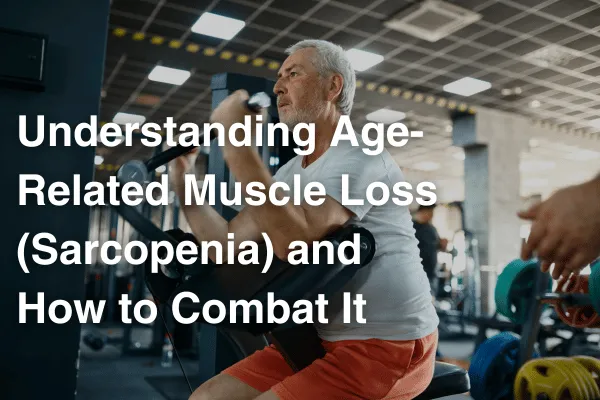(310) 294-1104
2173 Lomita Blvd. Lomita, CA 90717
BLOG
Still Got It Fitness Blog

Understanding Age-Related Muscle Loss (Sarcopenia) and How to Combat It
As we age, it's no secret that our bodies go through changes. One of the most impactful yet least understood is the gradual decline in muscle mass and strength, known as sarcopenia. This condition, can impact everything from balance to daily mobility and is a common cause of frailty and loss of independence in older adults. But the good news is that sarcopenia isn’t inevitable—and there are proactive steps you can take to slow, stop, or even reverse it.
In this post, we’ll explore what causes age-related muscle loss, why it’s so important to address, and practical ways to combat it to maintain strength, independence, and vitality as you age.
What is Sarcopenia?
Sarcopenia is a natural part of aging that involves the gradual loss of muscle mass, strength, and function. The term comes from the Greek words "sarx" (flesh) and "penia" (loss), essentially meaning "loss of flesh." Sarcopenia affects everyone to varying degrees, and while it’s influenced by genetics, lifestyle factors play a huge role in how significantly it affects us.
On average, adults can lose 3-8% of their muscle mass per decade after the age of 30, with the rate of decline increasing after 60. For some, sarcopenia can make it harder to perform even simple tasks, such as standing up from a chair, climbing stairs, or lifting everyday objects.
Causes of Age-Related Muscle Loss
There are several factors that contribute to muscle loss as we age:
Hormonal Changes: Declining levels of testosterone and growth hormone with age can contribute to muscle atrophy.
Reduced Physical Activity: Many adults become less active as they age, which can accelerate muscle loss. Sedentary lifestyles are one of the most significant factors in sarcopenia.
Nutritional Deficiency: A lack of adequate protein and certain vitamins, like vitamin D, can hinder muscle maintenance and repair.
Inflammation: Chronic, low-grade inflammation associated with aging (called “inflammaging”) may interfere with muscle repair and regeneration.
Neurological Changes: The loss of motor neurons as we age also contributes to reduced muscle mass and strength.
Why Is Combating Sarcopenia Important?
Maintaining muscle mass as we age isn’t just about looking toned or feeling strong. It plays a critical role in:
Mobility and Balance: Muscle strength helps us maintain our stability, reducing the risk of falls and fractures.
Metabolic Health: Muscle tissue is metabolically active and helps regulate blood sugar and other metabolic processes. Loss of muscle mass is linked to higher risks of conditions like type 2 diabetes and obesity.
Overall Independence: Muscle strength and mobility are essential for daily activities like getting out of bed, carrying groceries, and enjoying hobbies. Strong muscles support independent living and a better quality of life.
Strategies for Combating Sarcopenia
While sarcopenia is common, it’s not something you have to passively accept. Here are some effective strategies to combat age-related muscle loss:
1. Strength Training
Strength or resistance training is the most effective way to build and maintain muscle mass. Exercises such as weightlifting, resistance band exercises, or bodyweight exercises like push-ups and squats engage your muscles and encourage growth and repair. Ideally, aim for 2-3 sessions per week, focusing on both major muscle groups and functional movements.
If you're new to strength training, consider working with a trainer who specializes in fitness for older adults. A program like our Live Long and Strong Kickstart Program, designed specifically for people over 50, can help you get started safely and effectively.
2. Increase Your Protein Intake
Protein is the building block of muscle. Older adults often need more protein than younger people to stimulate muscle repair and growth. Aim for about 1.2–1.5 grams of protein per kilogram of body weight each day, distributed across meals.
3. Stay Active with Aerobic Exercise
While strength training is crucial, don’t forget aerobic exercise. Walking, cycling, swimming, and other cardiovascular activities improve circulation and heart health, which supports muscle function and reduces inflammation. Aim for 150 minutes of moderate-intensity cardio per week, and add variety to keep it engaging.
4. Get Enough Vitamin D
Vitamin D plays a role in muscle health, and deficiency is common, particularly in older adults. Spending time in sunlight, eating fortified foods, and, if needed, taking a supplement can help maintain healthy vitamin D levels. Talk to your doctor about testing and recommendations for appropriate supplementation.
5. Prioritize Recovery and Rest
Aging muscles take longer to repair after exercise, so giving your body adequate recovery time is essential. Listen to your body and incorporate rest days, proper hydration, and quality sleep into your routine.
Final Thoughts
Sarcopenia may be a common part of aging, but it’s far from inevitable. By adopting strength training, improving nutrition, staying active, and prioritizing recovery, you can combat age-related muscle loss effectively. Not only will you improve your physical capabilities, but you’ll also enhance your quality of life and independence.
If you’re ready to take proactive steps against sarcopenia, consider joining our Live Long and Strong Kickstart Program, which provides the guidance, training, and support you need to build strength, stay active, and enjoy your best years ahead. Remember, it’s never too late to start working on a stronger, healthier you!

ABOUT US
We are South Bay's #1 personal training studio for those over 50 who want to get out of pain and live better. Our programs are designed to improve quality of life so that you can continue to enjoy the activities you love. Since 2016 we have been serving the South Bay area with members coming from Lomita, Torrance, Palos Verdes, Rolling Hills, Redondo Beach, and San Pedro.
Still Got It Fitness
2173 Lomita Blvd.
Lomita, CA 90717
(310) 294-1104
Copyright ©2025 All rights reserved
